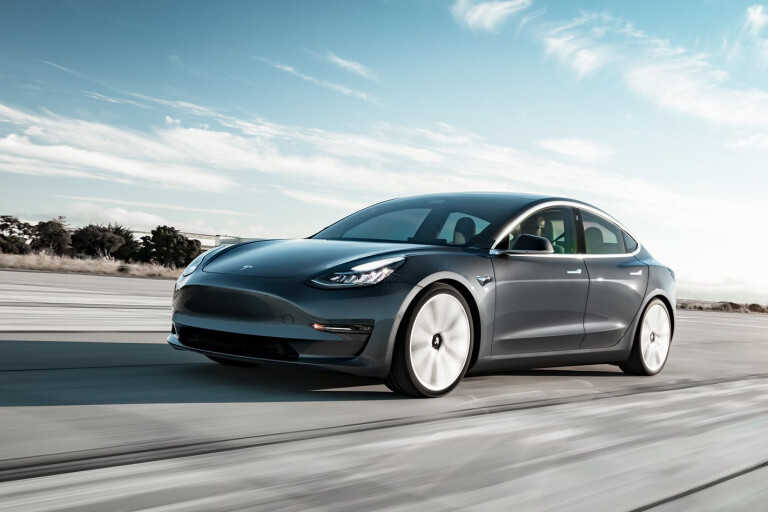
Overall Rating

Plus & Minus
Plus Powertrain strength and refinement; EV range; Capable of 250kW DC charging; service costs
Minus Rear-seat packaging; austere cabin ambiance; fit and finish; weight in hard driving
The Wheels Verdict: The most affordable of Tesla’s now three-model-strong lineup demands you abandon preconceptions of how you interact with a car. The lack of conventional instruments, a purely screen-based user interface and imitation leather-trimmed cabin won’t be for everyone at prices that span $66-91K. But the almost eerie acceleration, massive traction, exploitable dynamics and whole “new generation of motoring” vibe delivered by the Model 3 make it something quite unique in this segment. Further, the price of the entry-level model ⎼ $16,000 more expensive than the $50K Nissan Leaf hatchback ⎼ seems like compelling value in EV terms.
What is the Tesla Model 3?
A premium mid-size four-door sedan from the enigmatic American EV specialist. It was developed from a clean sheet in a little over half the time most rival manufacturers take to develop an all-new car, has been plagued by delays and over-promising, but is finally now being delivered to customers who placed deposits around three years ago.
Why we’re testing it
We’re well familiar with the other two Teslas in the current line-up (the Model S large sedan and Model X crossover), so naturally we jumped at the chance to finally drive a production version in Australia of what will be the company’s volume seller. However, our drive was limited to the top-spec Performance model on an ultra-smooth private test track, so real-world ride and dynamic assessment will have to wait another few weeks.
Tesla Model 3 review
Sliding into the driver’s seat of Tesla’s Model 3 is initially a little startling. It’s like coming home to find your sleek-chic Scandinavian-inspired apartment has been burgled, and all that’s been left behind by the thieving bastards is your iPad. ‘Minimalist’ doesn’t even begin to describe it. So my first question is not about the driving range, or the performance, nor why a premium EV targeting C-Class and 3 Series owners is trimmed in vinyl. No, what I want to know is: do you still call an instrument panel by that name if there are no instruments involved? It would seem more accurate in this instance to call the interior component that spans between the A-pillars the ‘tablet support beam’, or perhaps a ‘ventilation distribution module’, but neither are very catchy.
Probably better to just move on and get familiar with that 15-inch tablet, because everything ⎼ from adjusting the height and reach of the steering wheel, the mirrors, and even opening the boot and front trunk ⎼ are controlled from here. It’s also internet-connected and provides over-the-air updates to keep the software up-to-date, and allows Tesla to patch fixes for things as trivial as the wiper interval and as technical as battery charging speed.
A Tesla spokesperson explained that buttons and knobs are a surefire way for cabin design to quickly feel dated, so into the bin they went, except for two thumb-friendly multi-function controllers on the wheel. Oh, and a key fob is all a bit 2017, so don’t expect one of those. Instead, the car’s security and ignition is linked to your phone, unlocking and locking automatically as you approach or leave. Welcome to the future, folks, where clutter and function duplication have been banished.
Want to pop open the glovebox? Yep, the release is on the tablet. There isn’t even a head up display, so you’ll need to glance sideways at the top-right corner of the tablet to monitor your speed. Ergonomically optimised? I’m not so sure. Good thing it drives well. We sampled the top-spec Performance model, with a 188kW motor on the rear axle, a 147kW unit upfront, and a 75kWh battery providing a real-world range in excess of 430km. At $92,000, it undercuts the likes of the Mercedes-AMG C43 ($108K) and Audi’s tasty S4 ($99K), but smokes both of them with claimed 0-100km/h acceleration of 3.4 seconds, along with an ample 260km/h top speed. All of which it manages with just one gear.
It’s very possible you’re getting tired of hearing about EV performance that’s “eerie”, and “otherworldly” but, well, it’s kinda hard to describe this sort of acceleration any other way. The Model 3 has a beautifully calibrated throttle tip-in so low-speed manoeuvring requires no concentration on the go pedal, but give it a proper squirt and the instantaneous wallop of torque has the 20-inch Michelins clawing at the tarmac and brings the scenery rushing through the screen, with little more than the sound of disturbed air around the mirrors and muted thrum of rubber on bitumen. The massive rolling response is especially hard to resist, simply because you can deploy such solid shove without the slightly guilty conscience that often comes with filling the airspace with anti-social internal combustion exhaust noise.
Dynamically, eventually comparing the Model 3 with those AWD rivals from Germany will be properly instructive, because of the Tesla’s weight penalty. Yes, it carries the bulk of its 1900kg mass low, but the chassis still has more roll than you’d ideally like in a track environment ⎼ there are no adaptive dampers offered ⎼ and you soon need to nurse the regenerative brakes. Given the speed at which this thing arrives at corners, the stoppers simply won’t cope with repeated big, late hits after a few laps. On the road, with the re-gen function set to standard, this won’t be an issue, and in normal driving, the brake pedal will actually see bugger-all use.

- As for steering, the Model 3’s head of vehicle dynamics, former Aston Martin man Chris Porritt, (who has since left to work for Apple on its autonomous project) has gone for an ultra-quick rack, but one that provides little actual road feel. The wheel requires just two turns from lock to lock, so the nose is properly darty, presumably to help disguise the car’s mass. There are three steering weights to select from; I found the middle position the most agreeable for our track session. The response and precision are there, however, a less synthetic, more feelsome set-up would be preferable. But drive the 3 precisely and it rewards with plenty of lateral grip, and loads of traction that just slingshots the car from apex to exit. There’s a track mode (we were expressly forbidden to use) which, according to the Tesla specialist on hand, does allow ample power oversteer.
Packaging is the one area where I’m left most underwhelmed by the 3. But the good news first. There are no issues up front (although the A-pillars are thick enough to obscure full vision through the corner) and there’s ample oddments storage for driver and passenger. Luggage space is generous with a big boot and 60/40 split-fold seats (though have no boot release for this) and there’s a deep sub-floor recess. The front trunk is big enough to swallow a slab or big duffel bag, but there’s no spare wheel, nor even an inflation kit. Cop a flat and you’re waiting for roadside assistance.
But it’s the rear seat that’s the biggest concern. The seat base is low to allow headroom for six-footers, but the floor is high to accommodate the batteries, so those in the back will find their knees bent at an acute angle, and there’s a scarcity of toe room if the front occupants have their seats set to the lowest positions. So it’s fine as a family car with kids in the back but less ideal for long hauls with full-size adults.
All this only scratches the surface of the Model 3, though. There’s so much more to this car, like its five-star ANCAP rating that includes a near-perfect 96 percent score for adult occupant protection. Or the fact that every one of the three variants come fitted with all the hardware needed for fully autonomous operation. Only the software and government legislative compliance is missing, but there’s provision for the former to be optioned, with the expectation that the latter will follow. The likelihood of this is a debate for another time; as of this moment, the Model 3 provides what a 3 Series or C-Class can’t (for now), which must give old mate Elon a very warm inner glow.
Tesla Model 3 vs rivals
Fully-electric: Hyundai Kona Electric, Nissan Leaf, BMW i3 S,
Premium sedan: Mercedes-Benz C-Class, BMW 3 Series, Audi A4, Lexus IS, Genesis G70, Infiniti Q50
Tesla Model 3 specs and pricing Australia
Model: Tesla Model 3 Performance
Drive: Dual motors, 75kW/h battery
Max power: 335kW
Max torque: 640Nm
Transmission: singe-speed reduction gear
Weight: 1900kg (estimated)
0-100km/h: 3.4sec (claimed)
Economy: 18kW/h/100km (estimated)
Price: $91,200
On sale: Now


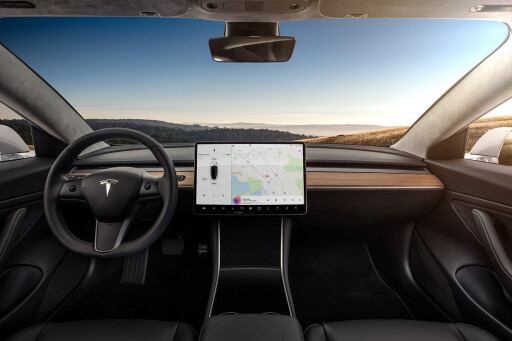
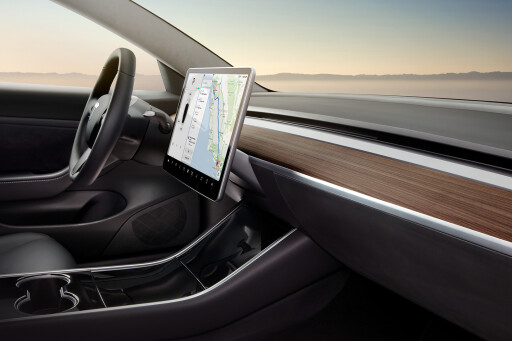

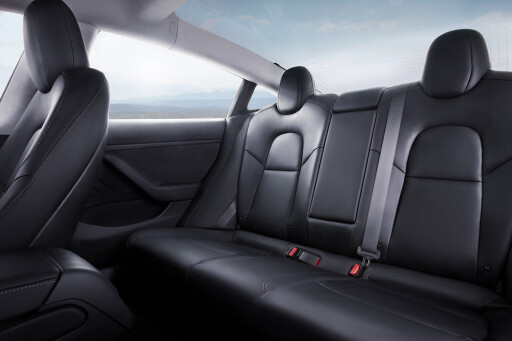
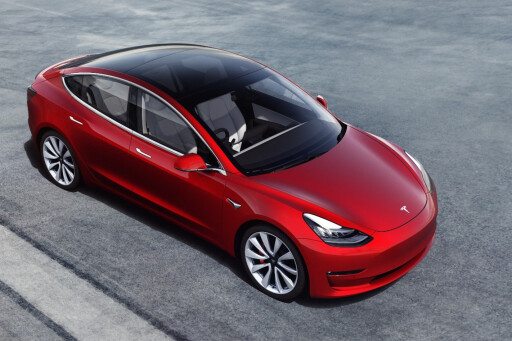

COMMENTS